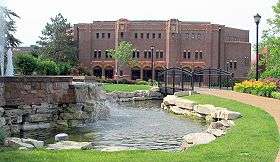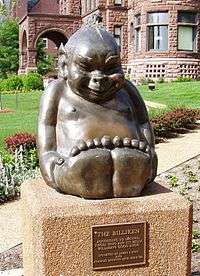Saint Louis University School of Medicine
 | |
| Type | Private |
|---|---|
| Established | 1836 |
Parent institution | Saint Louis University |
| Affiliation | Roman Catholic - Jesuit |
| Dean | Philip O. Alderson, M.D. |
Academic staff | 568 |
| Students | 707 |
| Location |
St. Louis, Missouri, USA 38°37′21″N 90°14′16″W / 38.6223686°N 90.2376879°WCoordinates: 38°37′21″N 90°14′16″W / 38.6223686°N 90.2376879°W |
| Campus | Urban |
| Website |
medschool |
Saint Louis University School of Medicine (SLUSOM) is a private, American Medical School within Saint Louis University. Located in the city of St. Louis, MO, Saint Louis University School of Medicine was established in 1836 and has the distinction of awarding the first M.D. degree west of the Mississippi River.
The school comprises about 700 medical students, 550 faculty members and 550 residents in 48 graduate medical education programs including residencies, subspecialty residencies and fellowships. The School is a pioneer in geriatric medicine, chronic disease prevention, cardiovascular disease, organ transplantation, neurosciences and vaccine research among others. It is a leading center of research in five key areas: cancer, infectious disease, liver disease, aging and brain disorders, and heart/lung disease.
It provides health services on a local, national, and international level while conducting medical research and training physicians and biomedical scientists of the future. Cardinal Glennon Children's Hospital and Saint Louis University Hospital are the two main affiliated teaching hospitals of the school.[1]
History
Saint Louis University School of Medicine was established in 1836 as the Medical Department of the University and had the distinction of awarding the first M.D. degree west of the Mississippi River in 1839. Several affiliated doctors of national importance include William Beaumont, whose pioneering studies of the human digestive system opened a new world of research, and Daniel Brainerd, who later founded Rush Medical College (then part of the University of Chicago). Cardinal Glennon Children's Hospital and Saint Louis University Hospital are the two main affiliated teaching hospitals of the school.
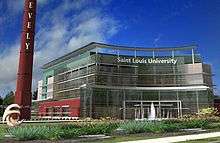
The Know-Nothing movement, an anti-immigrant and subsequently anti Catholic movement that surged through the United States in the 1840s and 1850s eventually led to the separation of the University's Medical Department from the University in 1854. As a result, the University was without a medical school for 59 years until the presidency of Father William Banks Rogers (1900 to 1908), during which plans were initiated for the integration of a new medical school into the University.
In 1903, the Marion Sims-Beaumont College of Medicine was incorporated into the University. At this time, Marion Sims-Beaumont College was a medical school owned and operated by a group of St. Louis physicians. The college's decision to merge with the University was greatly influenced and reinforced by the recommendations of the Council on Medical Education and Hospitals of the American Medical Association, which insisted that all schools of medicine be affiliated with a University. Assured of financial support from the St. Louis civic leader Festus J. Wade, President Rogers successfully secured the needed funds for the purchase of the Marion Sims-Beaumont College.
Since 1994, the students and physicians of the School of Medicine have been committed to providing free primary healthcare services in an academic environment through their Health Resource Center. They currently operate 8 free clinics throughout the Saint Louis area including an adult clinic, pediatric clinic, well woman clinic, cardiology clinic, diabetes clinic, homeless health clinic, extended services clinic, and their most recent addition, the asthma and allergy clinic.
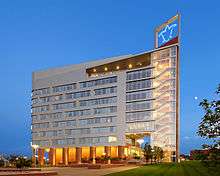
In 2007, a new research center was added to the university. Made of glass and steel in just 522 working days, the 10-story tower now stands at the northern gateway to the University's Medical Center. This 206,000 square-foot building is named after the late Dr. Edward Adelbert Doisy, who was not only a Nobel Laureate but also a professor at Saint Louis University for five decades. "The University's $82 million Edward A. Doisy Research Center is now the new home of Saint Louis University researchers working in five key areas of scientific discovery: cancer and molecular biology; liver disease; cardiovascular disease; neurosciences and aging; and vaccine development".[2]
Effective April 1, 2008, Philip O. Alderson, former chairman of the radiology department at Columbia University, became the 12th dean of the Medical School.
The medical school continues to be a leader in research in many fields, especially in emerging diseases, neuroscience, organ transplantation, vaccine development, cardiac health, and afflictions of the liver. Currently, numerous cutting edge research projects are underway including those examining aging and brain disorders, Alzheimer's disease, multiple sclerosis, biodefense, influenza, respiratory syncytial virus (RSV) and tuberculosis vaccines. Actually, the Saint Louis School of Medicine is one of only eight NIH-funded vaccine research institutions, and made significant contributions to the research and development of the H1N1 influenza vaccine. Furthermore, the Saint Louis University Liver Center is a national leader in the field of hepatology and is also considered one of the largest hepatitis C practices in the world.
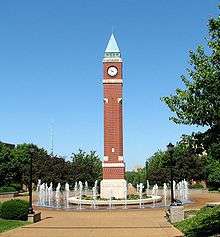
Rankings and admissions
Admissions to Saint Louis University School of Medicine is highly selective. Matriculates had an average GPA of 3.84 and an average MCAT score of 33 (Medical School Admission Requirements 2014 edition). Apart from these academic characteristics, the admissions committee recognizes a responsibility to consider applicants as individuals, particularly in the evaluation of the breadth of their educational experience, their personality traits, maturity level, and appropriate motivation and commitment to a career in medicine. For the most recent class to matriculate at Saint Louis University School of Medicine, 6,637 applicants competed for 175 seats.
Saint Louis University School of Medicine is currently ranked 69th for research by the 2012 edition of U.S. News and World Report of the 149 fully accredited U.S. medical schools (by the Liaison Committee on Medical Education and the American Osteopathic Association).[3] Additionally, Saint Louis University School of Medicine was recently ranked 54 among the nation's 130 medical schools surveyed and the school's geriatrics program was ranked number 13 in the nation.[4]
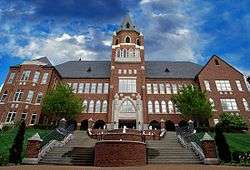
Dual degree programs
MD/MBA with the John Cook School of Business

MD/MPH Public Health and Medicine
MD/PhD Program
Notable alumni
- Irene D. Long, Chief Medical Officer, Kennedy Space Center.
- Ralph A. Kinsella, the first to demonstrate anti-inflammatory properties of salicylates.
- William S. Sly, Founder of Sly Syndrome (aka Mucopolysaccharidosis Type VII or MPS VII) and the Mannose 6 Phosphate Targeting Pathway.
- George E. Thoma, considered the "Father of Nuclear Medicine" and pioneer in the use of radio-isotopes in diagnostic imaging.
- Jan Garavaglia, "Dr. G," star of Dr. G: Medical Examiner on the Discovery Health Channel, author, and Chief Medical Examiner for District 9, Florida.
Gallery
References
External links
- St. Louis University School of Medicine home page
- University Names New Dean of the School of Medicine
- Research Finds Way to Eliminate Toxic Effect of Statins
- Journal Edited by SLU Geriatrician Among Most Cited in Field
- More Than 150 SLUCare Physicians Chosen as 'St. Louis Magazine's' "Best Doctors"
- SLU Neurosurgeon Authors First Textbook on High-Flow Brain Bypass Surgery
- SLU Doctor to Lead National Women’s Surgeon Group
| ||||||||||||||||||||||||||||||



